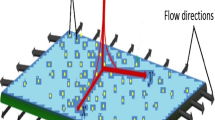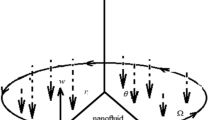Abstract
Omitting viscosity along flow direction, we have simplified the dimensionless N-S equations in arbitrary curved coordinate system as the thin layer equations. Using the implicit approximate-factorization algorithm to solve the gas-phase governing equations and the characteristic method to follow the tracks of particles, we then obtained the full coupled numerical method of two-phase, transonic, turbulent flow. Here, particle size may be grouped, the subsonic boundary condition at entry of nozzle is treated by quasi-characteristic method in reference plane and the algebraic model is used for turbulent flow. These methods are applied in viscous two-phase flow calculation of rocket nozzle and in the prediction of thrust and specific impulse for solid propellant rocket motor. The calculation results are in good agreement with the measurement values. Moreover, the influences of different particle radius, different particle mass fraction and particle size grouped on flow field have been discussed, and the influences of particle two-dimensional radial velosity component and viscosity on specific impulse of rocket motor have been analysed.
The method of this paper possesses the advantage of saving computer time. More important, the effect is more obvious for the calculation of particle size being grouped.
Similar content being viewed by others
References
Shang, I. S., One- and two-phase nozzle flows,AIAA, 80–272.
Fang Ding-you, Using the time-dependent method to calculate transonic flow field,J. of Aerodynamics, 2 (1985). (in Chinese)
Beam, R. M. and R. F. Warming, An implicit finite different algorithms for hyperbolic systems in convervation law form,J. Comput. Phys.,22 (1976).
Dash, S. M., D. E. Wolf, R. A. Beddinf and H. S. Pergament, Analysis of two-phase flow processes in rocket exhaust plumes,J. Spacecraft Rockets,22, 3 (1985).
Coakley, T. J. and J. M. Champeny, Numerical simulation of compressible, turbulent, two-phase flow,AIAA, 85–1666.
Fang Ding-you, Two-phase, transonic nozzle flow,J. of Astronautics, 3 (1987). (in Chinese)
Stger, J. L., Implicit finite different simulation of flow about arbitrary two-dimensional geometries,AIAA. J. 16, 7 (1978).
Zhang Han-xin, Yu Chu-ze, Lu Lin-sheng and Ma Zhan-kui, Numerical solution of separate flow for supersonic and hypersonic viscous gas,Acta Mechanica Sinica, 4 (1981). (in Chinese)
Barger, M. E., Performance prediction for solid rocket motor using a particle size change model,AIAA, 81–1577.
Baldwin, B. S. and H. Lomax, Thin layer approximation and algebraic model for separated turbulent flows,AIAA, 78–257.
Brown, E. F. and G. L. Hamilton, A survey of methods for exhaust-nozzle flow analysis,J. Aircraft,13, 1 (1976).
Hwang, C. J. and G. C. Chang, Numerical steady of gas particle flow in a solid rocket nozzle,AIAA J.,26, 6 (1988).
Zhang Yuan-jun (translation),Foundation of Gas-Particle Flow, National Defence Industry Publication House (1986). (Chinese version)
Author information
Authors and Affiliations
Additional information
Communicated by Chien Wei-zang
Project supported by the National Natural Science Foundation of China
Rights and permissions
About this article
Cite this article
Hong-qing, H., Xiao, H., Ti-min, C. et al. An implicit algorithm of thin layer equations in viscous, transonic, two-phase nozzle flow. Appl Math Mech 15, 323–334 (1994). https://doi.org/10.1007/BF02463710
Received:
Issue Date:
DOI: https://doi.org/10.1007/BF02463710




